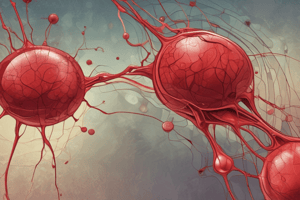Podcast
Questions and Answers
What is the primary focus of the test mentioned?
What is the primary focus of the test mentioned?
- Patient-specific clotting factors
- Factors involved in the extrinsic pathway
- Factors involved in the intrinsic pathway (correct)
- Overall clotting time analysis
What is the expected range for clotting time according to the content?
What is the expected range for clotting time according to the content?
- 10-15 min
- 5-10 min (correct)
- 3-8 min
- 0-5 min
Which of the following pathways is NOT associated with the test?
Which of the following pathways is NOT associated with the test?
- Extrinsic pathway (correct)
- Common pathway
- Intrinsic pathway
- Fibrinolytic pathway
If the clotting time falls outside the expected range, what might this indicate?
If the clotting time falls outside the expected range, what might this indicate?
Which of these factors is likely NOT involved in the intrinsic pathway?
Which of these factors is likely NOT involved in the intrinsic pathway?
What is the role of thrombin in blood coagulation?
What is the role of thrombin in blood coagulation?
What type of antibodies do Group A red blood cells (rbc's) have?
What type of antibodies do Group A red blood cells (rbc's) have?
What structural property do fibrin fibers exhibit in a clot?
What structural property do fibrin fibers exhibit in a clot?
Which statement is true regarding Group AB red blood cells?
Which statement is true regarding Group AB red blood cells?
How does the clot formed contribute to hemostasis?
How does the clot formed contribute to hemostasis?
What is formed after the polymerization of fibrin monomers?
What is formed after the polymerization of fibrin monomers?
What is a characteristic of Group A red blood cells?
What is a characteristic of Group A red blood cells?
What happens to the clot once it forms?
What happens to the clot once it forms?
Which blood group has both antigens A and B?
Which blood group has both antigens A and B?
What is the defining feature of Group AB red blood cells concerning antibodies?
What is the defining feature of Group AB red blood cells concerning antibodies?
What determines the ABO blood classification?
What determines the ABO blood classification?
Which antigens are present in the ABO blood group system?
Which antigens are present in the ABO blood group system?
What is the role of agglutinogens in blood classification?
What is the role of agglutinogens in blood classification?
Which of the following best describes the encoding of ABO blood types?
Which of the following best describes the encoding of ABO blood types?
In terms of blood classification, which antigen is NOT part of the ABO system?
In terms of blood classification, which antigen is NOT part of the ABO system?
What is the primary function of helper T cells in the immune system?
What is the primary function of helper T cells in the immune system?
What proportion of total T cells do helper T cells constitute?
What proportion of total T cells do helper T cells constitute?
Which type of T cell primarily functions to directly attack and kill infected cells?
Which type of T cell primarily functions to directly attack and kill infected cells?
What role do suppressor T cells mainly serve in the immune system?
What role do suppressor T cells mainly serve in the immune system?
Which of the following statements about T helper cells is incorrect?
Which of the following statements about T helper cells is incorrect?
Flashcards are hidden until you start studying
Study Notes
Fibrinogen to Fibrin Conversion
- Thrombin (IIa) acts on fibrinogen (Factor I) to produce fibrin monomer (Factor Ia)
- Fibrin monomers spontaneously polymerize into long fibrin fibers
- Fibrin fibers form the reticulum of the clot
- The clot is a network of fibrin fibers that traps blood cells, platelets, and plasma.
- The clot adheres to vascular openings to prevent blood loss
Intrinsic Pathway
- This test is sensitive to factors involved in the intrinsic pathway.
- The expected clotting time range is 5-10 minutes.
ABO Blood System
- The ABO blood system classification depends on the presence or absence of agglutinogens (antigens) on red blood cell surfaces.
- Two antigens, type A and type B, occur on the surface of red blood cells.
- Group A red blood cells have surface antigen A and antibody B.
- Group AB red blood cells have surface antigens A & B and no antibodies.
T Helper Cells
- T helper cells constitute about 75% of total T cells.
- T helper cells are major regulators of immune function.
- T helper cells produce protein mediators called lymphokines.
Studying That Suits You
Use AI to generate personalized quizzes and flashcards to suit your learning preferences.


